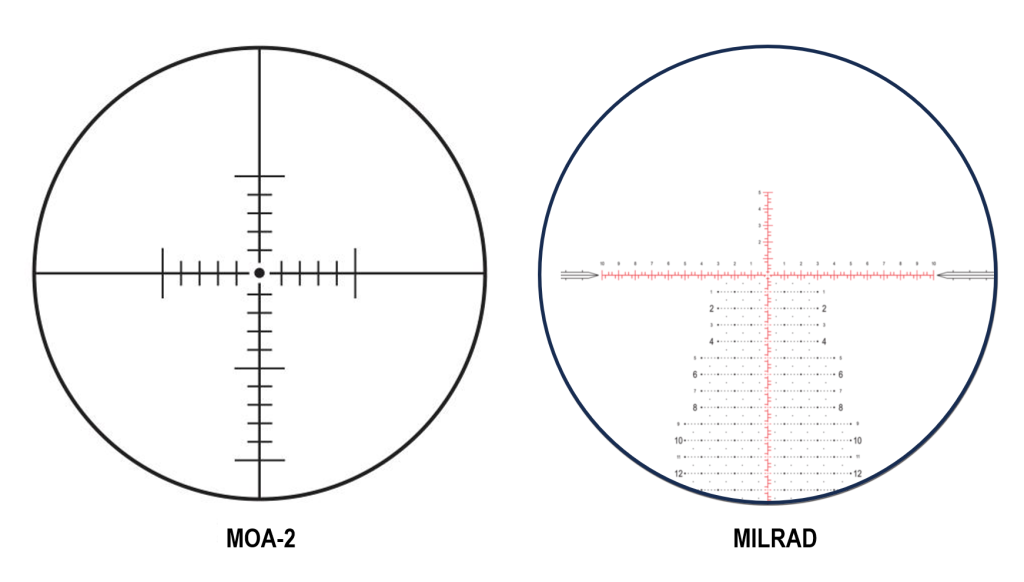When choosing a riflescope, one of the most commonly misunderstood aspects is the choice between MOA and MRAD. These two systems are used for adjusting and reading scope turrets and reticles — and while they both do the same job, they do it in different ways.
Whether you’re a new shooter buying your first optic or a seasoned marksman looking to upgrade, understanding the differences between MOA and MRAD will help you make a more informed choice.
What Are MOA and MRAD?
Both MOA (Minute of Angle) and MRAD (Milliradian) are angular units of measurement. They’re used to describe how much you’re adjusting your scope — either when dialing for elevation and windage or when using holdovers in your reticle.
Think of them as two different units for measuring the same thing — much like inches and centimeters. The key is to stick with one system consistently, as mixing them can get confusing quickly.
- MOA stands for Minute of Angle.
- 1 MOA equals 1/60th of one degree.
- At 100 yards, 1 MOA equals approximately 1.047 inches — most shooters simplify this to 1 inch at 100 yards for convenience.
- Scopes with MOA adjustments often use:
- 1/4 MOA clicks (each click moves the point of impact about 0.25 inches at 100 yards)
- 1/8 MOA clicks for finer adjustment in some high-precision optics
MOA is very common in the U.S., particularly for hunting, benchrest shooting, and traditional long-range rifle scopes.
MRAD: Milliradian
- MRAD stands for Milliradian, which is a metric-based angular unit.
- There are 6.283 radians in a full circle, and 1 radian = 1,000 milliradians.
- At 100 meters, 1 MRAD equals 10 centimeters, or about 3.6 inches at 100 yards.
- Scopes with MRAD adjustments usually use:
- 0.1 MRAD clicks (each click moves the point of impact 1 cm at 100 meters)
MRAD is often used in military, tactical, and precision rifle series (PRS) shooting, especially in countries using the metric system.
- Short- to mid-range shooting (e.g. under 500–600 metres)
- Hunting rifles where long-range adjustment isn’t critical
- Rifles with lower-power optics that have limited internal adjustment
- Rimfire rifles or low-recoil centerfire setups
- Shooters who want to maintain zero at close ranges (100m or less)
Comparing the Two Systems
| Feature | MOA | MRAD |
| Measurement Base | Imperial (yards, inches) | Metric (meters, centimeters) |
| Common Click Value | ¼ MOA (0.25″) @ 100 yards | 0.1 MRAD (1 cm) @ 100 meters |
| 1 Adjustment Unit Equals | ~1″ at 100 yards | 10 cm at 100 meters (~3.6″ @ 100 yd) |
| Number of Clicks per Turn | ~20-25 (¼ MOA) | ~10 (0.1 MRAD) |
| Precision | Finer adjustments | Slightly coarser, but simpler |
| Used By | Hunters, U.S. shooters, benchrest | Tactical, military, PRS, metric users |
Pros and Cons of MOA
Pros:
- Finer adjustments: With ¼ MOA clicks, MOA allows for very fine tuning, great for benchrest and precision shooters.
- Feels familiar: Many shooters (especially in the U.S.) are already used to inches and yards.
- Easier to estimate group sizes at 100 yards (e.g. “my group is 1 MOA”).
Cons:
- Math can be slightly more complex, especially at distances other than 100 yards.
- If you’re using a metric-based range, conversions may slow you down.
Pros and Cons of MRAD
Pros:
- Simpler math in the metric system (e.g. 1 MRAD = 10 cm at 100m).
- Common in tactical and military settings; standardized in PRS and long-range competition.
- Fewer clicks per adjustment, which can be quicker when dialing.
Cons:
- Coarser adjustments than MOA if you prefer ultra-fine tuning.
- Less intuitive for shooters used to inches and yards.
Which One Is More Precise?
Technically, ¼ MOA clicks (about 0.26″ at 100 yards) are slightly finer than 0.1 MRAD clicks (about 0.36″ at 100 yards). This can matter for extreme precision shooting, such as benchrest competitions.
However, in practical terms, both systems are extremely accurate, and most shooters won’t notice the difference in real-world performance. The best system is the one you’re most comfortable using.
Which System Should You Choose?
The best system depends on your personal shooting style and preferences:
- Choose MOA if:
- You shoot in yards and inches
- You do benchrest or hunting and prefer ultra-fine adjustment
- You’re already used to MOA and want to stay consistent
- Choose MRAD if:
- You shoot in meters and centimeters
- You participate in PRS, tactical, or military-style shooting
- You want to do faster calculations and use reticles more dynamically
Final Thoughts
At the end of the day, both MOA and MRAD are capable of precision shooting — the key is consistency. Stick with one system for your scope, range estimation, and ballistic data. Switching between them mid-session can lead to confusion, miscalculations, and missed shots.
There’s no “right” or “wrong” answer here — just what’s right for you. Whether you’re ringing steel at 1,000 meters or stalking deer in the bush, pick the system that matches your shooting habits and feels most natural.

